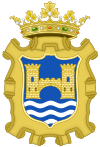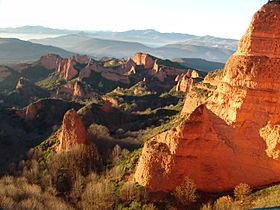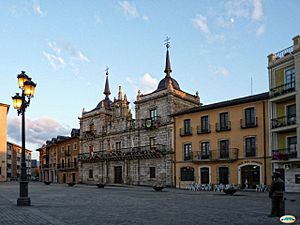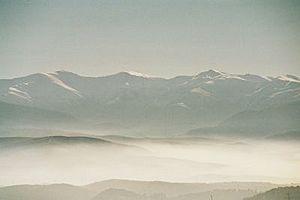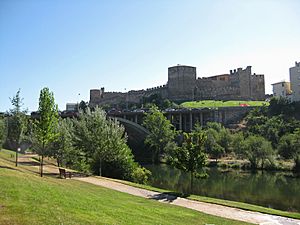Ponferrada facts for kids
Quick facts for kids
Ponferrada
|
|||
|---|---|---|---|
|
|||
| Country | Spain | ||
| Autonomous Community | Castilla y León | ||
| Province | León | ||
| Region | El Bierzo | ||
| Founded | 11th century | ||
| Area | |||
| • Total | 283 km2 (109 sq mi) | ||
| Elevation | 544 m (1,785 ft) | ||
| Population
(2005)
|
|||
| • Total | 65,984 | ||
| • Density | 233.15/km2 (603.9/sq mi) | ||
| Time zone | UTC+1 (CET) | ||
| • Summer (DST) | UTC+2 (CEST) | ||
| Postal code |
244xx
|
||
| Area code(s) | 987 | ||
| Website | www.ponferrada.org | ||
Ponferrada (from the Latin Pons Ferrata, Iron Bridge) is the capital city of El Bierzo in the Province of León, Spain. It lies on Sil River and it is completely surrounded by mountains. It is the last major town on the French route of the Camino de Santiago before it reaches Santiago de Compostela. In 2008, it had a population of 69,769.
Contents
History
In pre-Roman times the region was populated by the Astures, a Hispano-Celtic Gallaecian people. They were conquered by Emperor Augustus in the Astur-Cantabrian Wars (29-19 BC) and the area quickly became the largest mining center of the Empire during the Roman period, where gold and other metals and minerals were extracted. Numerous Roman mining sites are still visible in the area, one of the most spectacular being Las Médulas, a UNESCO World Heritage Site since 1997. Romans also imported grapevines, and wine production thrived in the region until the propagation of Phylloxera at the end of the 19th century, which destroyed the majority of the vineyards.
The modern name of the city derives from the iron reinforcements added to the ancient bridge over the river Sil (Latin pons for "bridge" and ferrata for "iron"), commissioned in 1082 by Bishop Osmundo of Astorga to facilitate the crossing of the Sil River to pilgrims in their way to Santiago de Compostela.
The railroad arrived in Ponferrada in 1881, and during World War I local tungsten deposits were exploited to supply the arms industry. In 1918 the Ponferrada Mining, Iron and Steel Company (Spanish: Minero Siderúrgica de Ponferrada (MSP)) was founded to exploit coal deposits in the region, and it grew to become Spain's largest coal mining corporation. The Spanish National Energy Corporation (Endesa) was founded in 1944 and in 1949 it opened Spain's first coal-fueled power plant in Ponferrada, Compostilla I. In 1960 the Bárcena Dam (Spanish: Pantano de Bárcena) opened and by the second half of the 20th century the economy of the city was mainly based on mining and electricity generation, both hydroelectric and coal-fueled.
Starting in the late 1980s most mines were closed, and after the collapse of the mining industry Ponferrada was for a while in a crisis. However, in the late 1990s the city underwent a major transformation with the establishment in the city of several industrial and services firms, the reintroduction of commercial wine production, the opening of a local branch of the University of León offering several undergraduate degrees, and in general a radical improvement of the town's infrastructure. The economy is now based mainly on tourism, agriculture (fruit and wine), wind power generation and slate mining, with a mild but constant population increase.
Important factors contributing to the recent boom of the tourism industry are the increasing popularity of the Way of St. James (Spanish: Camino de Santiago; a pilgrimage route that goes from France to Santiago de Compostela, Galicia), the designation in 1997 of Las Médulas as a UNESCO World Heritage Site and the development of rural tourism lodging and wineries in the area. The Energy City Foundation Spanish: Fundación Ciudad de la Energía was established in Ponferrada in 2006 and is currently overseeing the construction of the National Energy Museum (Spanish: Museo Nacional de la Energía) in the city, as well as sponsoring several other initiatives that should further boost tourism and the economy of the city and its region.
Tourism
Main sights
Ponferrada lies in the Way of St. James, a UNESCO World Heritage Site, and every year many pilgrims pass through the city in their way to Santiago de Compostela. Las Médulas, ancient Roman gold mines also included in the UNESCO World Heritage Site List, are only a few kilometres away from the city.
Ponferrada is also noted for its Castillo de los Templarios, a Templar castle which covers approximately 16,000 square meters. In 1178, Ferdinand II of León donated the city to the Templar order for protecting the pilgrims on the Way of St. James who passed through El Bierzo in their road to Santiago de Compostela.
The castle hosted the Knights Templar's Grand Master of Castille. However, the Templars were only able to enjoy the use of their fortress for about twenty years before the order was disbanded and its properties confiscated in 1311. Several noble houses fought over the assets until Alfonso XI allotted them to the Count of Lemos in 1340. Finally the Catholic Monarchs incorporated Ponferrada and its castle into the Crown in 1486. As with many other historical sites in Europe, many of the blocks that at one point formed the walls of the castle were removed and used in local construction projects. Extensive restoration works are ongoing.
The Basilica de la Encina is a church built in the Renaissance style in 1573. Its baroque tower dates from 1614.
The El Bierzo Museum offers a tour of the history of the region and hosts several important archeological pieces, while the Museum of Radio offers an interesting tour of the history of the radio in Spain. The National Energy Museum is currently under construction, sponsored by the Energy City Foundation. It will include the restored building and equipment of Compostilla I, Spain's first coal-fueled power plant opened in 1949 in Ponferrada.
The church of Santiago de Peñalba (an example of Mozarabic art), the Hermitage of Santo Tomás de las Ollas (10th century) and the Romanesque Church of Santa María de Vizbayo are also nearby.
The highest view from the city, is the Torre de la Rosaleda, in the Roseleda district, the tallest building in Ponferrada.
Culture
Ponferrada has several primary and secondary education centers, as well as a public language school (Escuela Oficial de Idiomas) which offers English, French, German, Portuguese and Galician language courses. The city also hosts a University of León campus, which offers several undergraduate degrees, and a UNED branch, which provides distance undergraduate education.
Theatre productions perform regularly at the local Teatro Bergidum, and there is a local multiplex cinema with seven screens. The city hosts regional (El Bierzo Museum) and radio (Museum of Radio) museums, and the National Energy Museum is currently under construction. Each year the city hosts music and cinema festivals, and hosts the annual Golden Microphone (Spanish: Premios Micrófono de Oro) award ceremony. These prizes are awarded by the Spanish Federation of Radio and Television Associations (Spanish: Federación de Asociaciones de Radio y Televisión) to recognize the outstanding careers of radio professionals in Spain.
Images for kids
-
Library of the University of León's campus in Ponferrada.
-
El Toralín, the home turf of SD Ponferradina.
See also
 In Spanish: Ponferrada para niños
In Spanish: Ponferrada para niños



